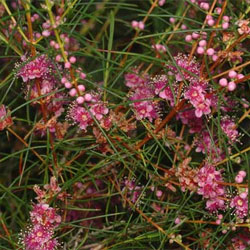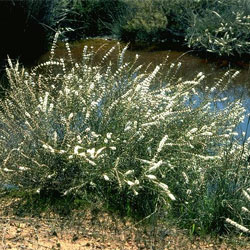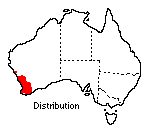Hypocalymma angustifolium
 |
 |
Pink-flowered Myrtle
Hypocalymma angustifolium (Endl.) Schauer
The Pink-flowered Myrtle (Hypocalymma angustifolium) is a small shrub related to the Tea Tree (Leptospermum) and the Bottlebrush (Callistemon) and common in Western Australia. It is unusual and dainty when flowering for a few weeks in spring and does best when found a position sheltered from strong winds. It is frost hardy, but not a tough subject either in winter storms or summer heat. Growth is dry and fragile and an exposed plant is liable to be blown sideways, becoming a poor shape, with bare wood. In shelter, however, with adequate water and with yearly pruning for bushy growth, a more lush plant results which will live a good number of years with continued care. When five years old it will probably be a dense shrub 1 m high with flexible, thin weeping branches.
 Leaves
are up to 2.5 cm long and linear. They emerge from the greyish papery stems
in opposite pairs either at right angles or reflexed and the effect is spiky.
When bruised their perfume is sweet and spicy. General appearance through the
year is dull or inconspicuous, but the flowers always attract attention when
the season begins in October or even mid-September in early years. They are
set close on the stems in whorls of three of four in the axils of the leaves,
and like them are very regular and neat. Opening first at the stem tips, flowers
are cup-shaped with stamens very prominent giving a fringed effect. Colour may
be white, cream or pink and the pink forms deepen to red with age so that there
is always a range of soft carmine tints along the stems. Bees are often seen
visiting the small flowers. New tips are growing as flowering passes, and these
when half ripe are used as cuttings for propagation. Seed has not been found
here.
Leaves
are up to 2.5 cm long and linear. They emerge from the greyish papery stems
in opposite pairs either at right angles or reflexed and the effect is spiky.
When bruised their perfume is sweet and spicy. General appearance through the
year is dull or inconspicuous, but the flowers always attract attention when
the season begins in October or even mid-September in early years. They are
set close on the stems in whorls of three of four in the axils of the leaves,
and like them are very regular and neat. Opening first at the stem tips, flowers
are cup-shaped with stamens very prominent giving a fringed effect. Colour may
be white, cream or pink and the pink forms deepen to red with age so that there
is always a range of soft carmine tints along the stems. Bees are often seen
visiting the small flowers. New tips are growing as flowering passes, and these
when half ripe are used as cuttings for propagation. Seed has not been found
here.
Most nurseries stock this shrub. When planting out the local lighter soils are suitable, as long as free from lime. From early stages it is a good plan to give a mulch of leaf mould or compost around a young plant to keep the soil cool, along with light trimmings for bushy growth. With adequate water it then grows away quickly and flowers while young. Serious pests and diseases have not been noticed.
This is a very pretty shrub for cutting, easy to arrange and lasts in shallow water for a long time. It will sometimes dry out if left, keeping enough colour for use in dried arrangements.
Based on text by Irene Beeton (1971)
Name meaning: Hypocalymma angustifoliumHypocalymma - from two Greek words meaning 'under' and 'a veil', alluding to the calyx; angustifolium - narrow leaved |
![An Australian Government Initiative [logo]](/images/austgovt_brown_90px.gif)

